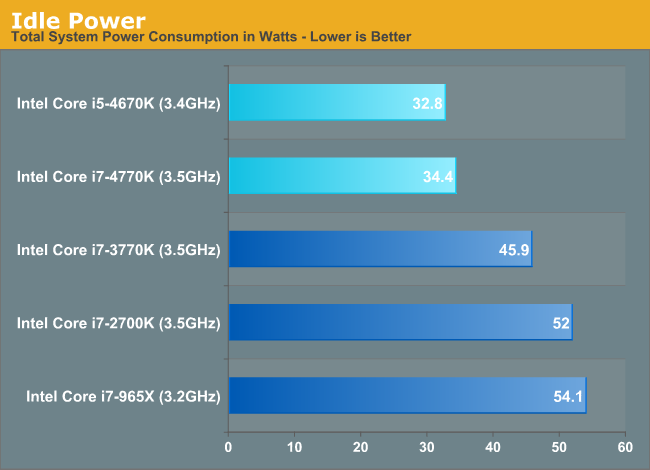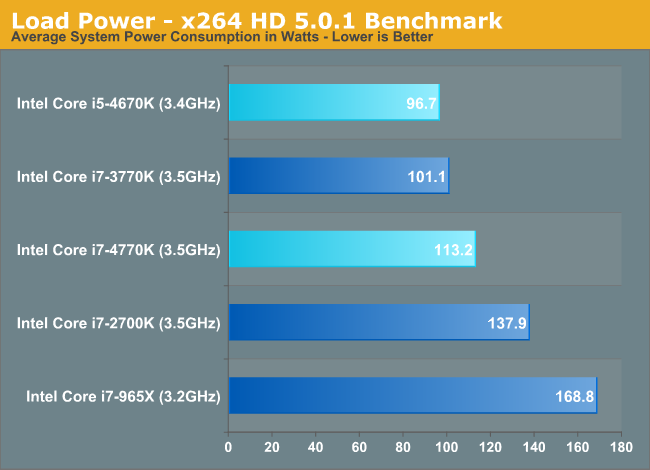The Haswell Review: Intel Core i7-4770K & i5-4670K Tested
by Anand Lal Shimpi on June 1, 2013 10:00 AM ESTPower Improvements
Although Haswell’s platform power is expected to drop considerably in mobile, particularly with Haswell U and Y SKUs (Ultrabooks and ultrathins/tablets), there are benefits to desktop Haswell parts as well.
There’s more fine grained power gating, lower chipset power and the CPU cores can transition between power states about 25% quicker than in Ivy Bridge - allowing the power control unit to be more aggressive in selecting lower power modes. We’ve also seen considerable improvements on lowering platform power consumption at the motherboard level as well. Using ASUS’ Z77 Deluxe and Z87 Deluxe motherboards for the Haswell, Ivy and Sandy Bridge CPUs, I measured significant improvements in idle power consumption:

These savings are beyond what I’d expect from Haswell alone. Intel isn’t the only one looking to make things as best as can be in the absence of any low hanging fruit. The motherboard makers are aggressively polishing their designs in order to grow their marketshare in a very difficult environment.
Under load, there’s no escaping the fact that Haswell can burn more power in pursuit of higher performance:

Here I’m showing an 11.8% increase in power consumption, and in this particular test the Core i7-4770K is 13% faster than the i7-3770K. Power consumption goes up, but so does performance per watt.
The other big part of the Haswell power story is what Intel is calling FIVR: Haswell’s Fully Integrated Voltage Regulator. Through a combination of on-die and on-package circuitry (mostly inductors on-package), Haswell assumes responsibility of distributing voltages to individual blocks and controllers (e.g. PCIe controller, memory controller, processor graphics, etc...). With FIVR, it’s easy to implement tons of voltage rails - which is why Intel doubled the number of internal voltage rails. With more independent voltage rails, there’s more fine grained control over the power delivered to various blocks of Haswell.
Thanks to a relatively high input voltage (on the order of 1.8V), it’s possible to generate quite a bit of current on-package and efficiently distribute power to all areas of the chip. Voltage ramps are 5 - 10x quicker with FIVR than with a traditional on-board voltage regulator implementation.
In order to ensure broad compatibility with memory types, there’s a second input voltage for DRAM as well.
FIVR also comes with a reduction in board area and component cost. I don’t suppose this is going to be a huge deal for desktops (admittedly the space and cost savings are basically non-existent), but it’ll mean a lot for mobile.
No S0ix for Desktop
You’ll notice that I didn’t mention any of the aggressive platform power optimizations in my sections on Haswell power management, that’s because they pretty much don’t apply here. The new active idle (S0ix) states are not supported by any of the desktop SKUs. It’s only the forthcoming Y and U series parts that support S0ix.










210 Comments
View All Comments
chizow - Saturday, June 1, 2013 - link
The other big problem with the CPU space besides the problems with power consumption and frequency, is the fact Intel has stopped using it's extra transistor budget from a new process node on the actual CPU portion of the die long ago. Most of the increased transistor budget afforded by a new process goes right to the GPU. We will probably not see a stop to this for some time until Intel reaches discrete performance equivalency.Jaybus - Monday, June 3, 2013 - link
Well, I don't know. Cache sizes have increased dramatically.chizow - Monday, June 3, 2013 - link
Not per core, these parts are still 4C 8MB, same as my Nehalem-based i7. Some of the SB-E boards have more cache per core, 4C 10MB on the 3820, 6C 15MB on the 3960/3970, but the extra bit results in a negligible difference over the 2MB per core on the 3930K.Boissez - Sunday, June 2, 2013 - link
I think you've misunderstood me.I'm merely pointing out that, in the past 2½ years we've barely seen any performance improvements in the 250-300$ market from Intel. And that is in stark contrast to the developments in mobileland. They too, are bound by the constraints you mention.
And please, stop the pompous know-it-all attitude. For the record, power consumption actually rises *linearly* with clock speed and *quadratically* with voltage. If your understanding of Joule's law and Ohm's law where better developed you would know.
klmccaughey - Monday, June 3, 2013 - link
Exactly. And it won't change until we see optical/biological chips or some other such future-tech breakthrough. As it is the electrons are starting to behave in light/waveform fashion at higher frequencies if I remember correctly from my semiconductor classes (of some years ago I might add).Jaybus - Monday, June 3, 2013 - link
Yes, but we will first see hybrid approaches. Intel, IBM, and others have been working on them and are getting close. Sure, optical interconnects have been available for some time, but not as an integrated on-chip feature which is now being called "silicon photonics". Many of the components are already there; micro-scale lenses, waveguides, and other optical components, avalanche photodiode detectors able to detect a very tiny photon flux, etc. All of those can be crafted with existing CMOS processes. The missing link is a cheaply made micro-scale laser.Think about it. An on-chip optical transceiver at THz frequencies allows optical chip-to-chip data transfer at on-chip electronic bus speeds, or faster. There is no need for L2 or L3 cache. Multiple small dies can be linked together to form a larger virtual die, increasing productivity and reducing cost. What if you could replace a 256 trace memory bus on a GPU with a single optical signal? There are huge implications both for performance and power use, even long before there are photonic transistors. Don't know about biological, but optical integration could make a difference in the not-so-far-off future.
tipoo - Saturday, June 1, 2013 - link
It's easier to move upwards from where ARM chips started a few years back. A bit like a developing economy showing growth numbers you would never see in a developed one.Genx87 - Saturday, June 1, 2013 - link
Interesting review. But finding it hard to justify replacing my i2500K. I guess next summer on the next iteration?kyuu - Saturday, June 1, 2013 - link
Agreed, especially considering Haswell seems to be an even poorer overclocker than Ivy Bridge. My i5-2500k @ 4.6GHz will be just fine for some time to come, it seems.klmccaughey - Monday, June 3, 2013 - link
Me too. I have a 2500k @ 4.3Ghz @ 1.28v and I am starting to wonder if even the next tick/tock will tempt me to upgrade.Maybe if they start doing a K chip with no onboard GPU and use the extra silicon for extra cores? Even then the cores aren't currently used well @ 4. But maybe concurrency adoption will increase as time goes by.